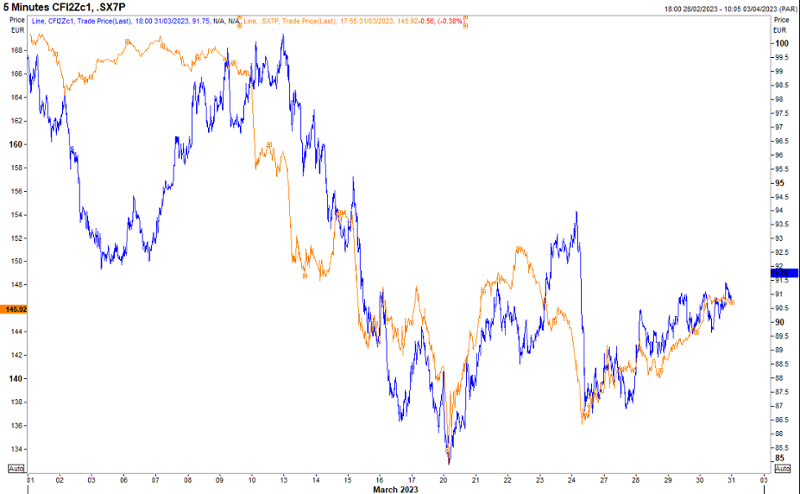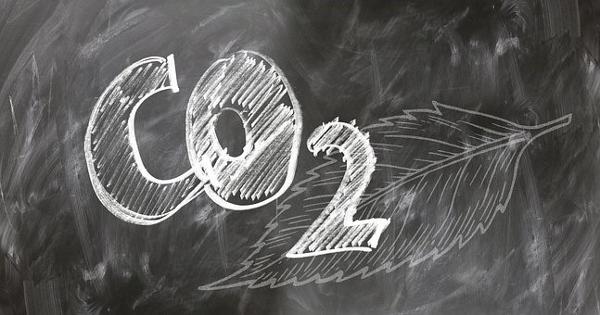The unfolding bank crisis in March left its mark on European carbon market too. The turmoil in wider financial markets and plummeting banks shares have pulled down the benchmark EUA contract to below €90/t. This is sharply down from the near €100/t level at the beginning of March boosted by compliance demand and the agreement of ETS reform proposals.
Over the weekend on 11 and 12 March, the collapsing of Silicon Valley Bank kept global financial market in nervous mood. Then, on Monday 13 March, the benchmark EUA contract (December 2023 futures) opened the day very strong at €100.16/t to resume the rally from the previous week due to worries over French nuclear outages. But the tide quickly turned as plunging European equities on financial contagion fears caused sell-off in many assets including EUAs. EURO STOXX banks index plunged near 10% on the day. The Dec-23 EUA futures fell to below €90/t on 15 March, and the fears of meltdown in financial system continued to weigh on sentiment. Price then regained some ground as market watched the efforts by the U.S. government to tackle the crisis.
However, the banking turmoil was far from over and Credit Suisse became the next. European banking sector was thrown into chaos again on 20 March despite the hastened deal by Swiss government to rescue Credit Suisse. Bank shares plummeted again, and European carbon price crashed to €85/t. Carbon price remained in the hands of shifting macro sentiment. On 24 March, Deutsche Bank shares fall more than 10% after the bank's credit default swaps shot to a four-year high. The sour sentiment across bank sector dragged EUA to below €90. In the final week of March, the benchmark EUA contract rebounded to near €92/t on improving macro sentiment and colder weather supporting the energy commodities.
Development of European Carbon price (blue, in euro/t) and EURO STOXX banks index (orange, left) in March 2023

Source: Refinitiv Eikon
The impacts of the bank crisis on EUA price could be explained from the two aspects below.
First, there are considerable number of financial institutions participating the European carbon market. They are either intermediaries helping power generators or industrials or aircraft operators to procure allowances for compliance, or institutional investors buying EUA futures as an investment asset to hedge its climate risk exposure. Then, with the banking crisis causing the sharp decline in banks’ shares, many investors are forced to sell some assets to cover their losses elsewhere. Daily trading volumes of the most liquid December EUA futures surged to an average of 35 million tonnes per day in the middle of March, far above the average of 20 million tonnes in February. This indicated the liquidation of positions by some investors. Similarly, when macro sentiment has improved and fears of banking crisis receded, investors will buy back some of the EUA positions which supported the rebound in carbon prices lately.
Second, the banking crisis especially the woes of European banks such as Credit Suisse and Deutsche Bank caused somewhat pessimistic outlook for EU economy. This has put downward pressure on EUA prices because the potential slowdown in economic activities will result in lower industrial output and energy demand. Lower emissions will mean laxer balances in European carbon market and reduced demand for allowances.
It is also worth noting that the banking crisis has changed market expectations of the interest rate pathway by the central banks, including US Fed and ECB. This shift will also affect EUA trading, because its forward curve is often tied closely with the risk-free interest rate with EUA often used as ‘inflation hedge’.
Overall, the recent bank crisis has had large impacts on EUA prices and this relationship will remain tight going forward too. Macro sentiment will underpin the development in European carbon prices in the near term, in addition to other carbon-specific drivers including energy complex, ETS policy, the REPowerEU EUA sales’ timetable etc. Compliance demand ahead of the April deadline has supported EUA prices in the first quarter, but this support will wane soon as the compliance season ends.




















